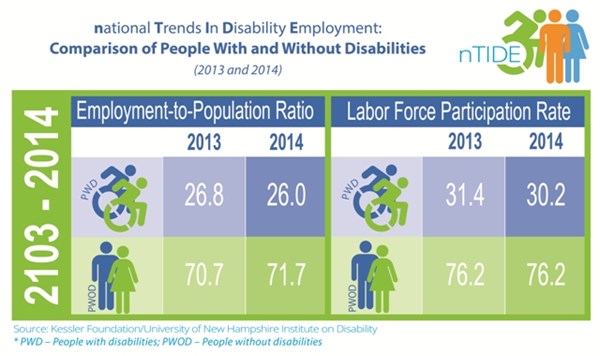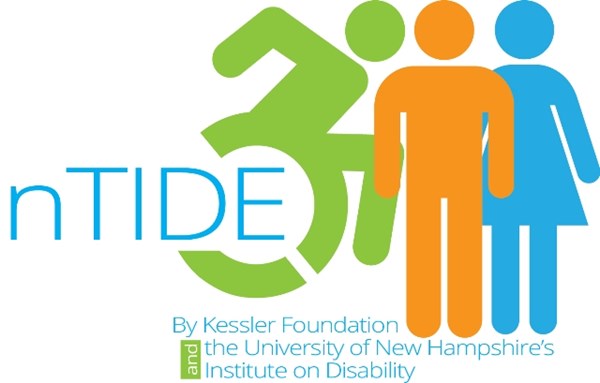WEST ORANGE, N.J., Feb. 5, 2015 (GLOBE NEWSWIRE) -- Although 2014 was a tough year overall for jobseekers with disabilities, the last three months show considerable improvement in employment rates, fueling optimistic expectations for 2015. These findings are detailed in this special year-in-review edition of the National Trends in Disability Employment (nTIDE). Released monthly in conjunction with the Bureau of Labor Statistics report, nTIDE is a collaborative effort of Kessler Foundation and the University of New Hampshire Institute on Disability (UNH-IOD) that compares the employment of Americans with disabilities with their peers without disabilities.
For Americans with disabilities, two key indicators showed declines this year – the employment-to-population ratio and the labor force participation rate. In 2014, the average monthly employment-to-population ratio—the percentage of people who are working relative to the total population—declined for people with disabilities to 26.0 percent, from 26.8 percent in 2013. This downward trend dates back to 2010, the first year annual comparisons became available. In contrast, for Americans without disabilities, the average monthly employment-to-population ratio rose from 70.7 percent in 2013 to 71.7 percent in 2014, continuing an upward trend that began in 2012.
For people with disabilities, the average monthly labor force participation rate—the percentage of people who are working or actively looking for work—dropped to 30.2 percent, down from 31.4 percent in 2013, continuing a downward trend that began in 2010. Among people without disabilities, the average labor force participation rate remained constant at 76.2 percent in 2013 and 2014, a halt in the decline that started in 2010.
"These annual numbers are consistent with an overall downward trend in the employment outlook for people with disabilities, raising concern that people with disabilities were not participating in the recovery from the Great Recession," said Andrew Houtenville, Ph.D., Associate Professor of Economics at UNH-IOD. At the end of 2014, however, these two key indicators turned positive for jobseekers with disabilities. October's employment-to-population ratio was higher than in October 2013. This positive news continued into November and December. In addition, December 2014 saw the first rise in the labor force participation rate since December 2013.
"The latter part of 2014 was strikingly positive and we are eager to see whether the good news continues in 2015," said John O'Neill, Ph.D., Director of Employment and Disability Research at Kessler Foundation. "Initiatives from nonprofits and corporations are underway to boost the training, hiring and retention of talented individuals with disabilities."
Ongoing efforts in the federal, public and private sectors are expanding job opportunities for people with disabilities on a large scale. Highlights of 2014 and previews of 2015 include:
- In 2010, President Obama issued a mandate to government employers and federal contractors to add 100,000 individuals with disabilities to the workforce over the next five years. A report by the U.S. Office of Personnel Management stated that in 2013, people with disabilities were added to the federal payroll at a rate higher than for any other period in the last three decades. A total of 234,395 federal workers with disabilities were hired in the first three years of the mandate. Entering 2015, the disability field as well as the government will be monitoring the mandate's impact.
- Tom Harkin, while Senator and chairman of the Senate Committee on Health, Education, Labor and Pensions, set a goal to increase the workforce participation of people with disabilities from 4.9 million to 6 million workers in 2015—an increase of more than 20 percent. To reach this goal, the U.S. workforce must add a million workers with disabilities.
- Two pieces of legislation—the Workforce Innovation and Opportunity Act (WIOA) and Section 503 of the Rehabilitation Act—were implemented to remove barriers for jobseekers with disabilities. With WIOA, more individuals with disabilities will have access to job training and employment services. Section 503 prevents federal contractors from discriminating against jobseekers with disabilities and encourages setting a hiring goal to have 7 percent of their workforce comprised of people with disabilities.
- Private funding is also supporting disability employment initiatives. At the close of 2014, Kessler Foundation awarded $2.1 million in grants to organizations across the nation to expand employment opportunities for people with disabilities. ServiceSource of Florida's "Warrior Bridge Brain Injury Demonstration Project," for example, will increase community integration, self-sufficiency and employment outcomes for individuals with brain injury, including veterans. "21 and Able," an initiative of United Way of Allegheny County in Pennsylvania, will build the capacity of businesses to employ and retain young people with disabilities. "Supporting initiatives that lead to large numbers of hires is essential to enabling more people with disabilities to earn a paycheck and contribute to the economy," said Elaine E. Katz, Senior Vice President of Grants and Communications. "Programs that develop the job skills of young people with disabilities and work with employers to aid in accommodations are essential to supporting the transition from school to careers. By starting interventions early, we will be fixing the problem before it even begins."
- Global organizations are implementing initiatives that increase the hiring and retention of people with disabilities. In 2013, Kessler Foundation awarded $450,000 to Ability Beyond to partner with PepsiCo's initiative, Pepsi ACT (Achieving Change Together). In the project's first year, people with disabilities found lasting employment as managers, loaders, mechanics and merchandisers in the pilot locations in Houston, TX, Burnsville, MN and Las Vegas, NV. Employees earn competitive wages.
- July 26, 2015 marks the 25th Anniversary of the Americans with Disabilities Act (ADA). To assess the effects of the ADA on employment, Kessler Foundation awarded $500,000 to the University of New Hampshire (UNH) to conduct the "Kessler Foundation National Employment Survey on the Status of Americans with Disabilities." The survey will help determine what services are useful in securing employment. Kessler Foundation and UNH will announce the survey results in June on Capitol Hill.
"We know that millions of individuals with disabilities want to work and have the ability to succeed," said Rodger DeRose, president and chief executive officer of Kessler Foundation. "They just need the opportunity. This survey will guide government leaders and the disability field in developing strategies to create these necessary opportunities. When more Americans of all abilities are working, the economy will flourish."
The next nTIDE Report will be released on February 6, 2015.
NOTE: The statistics in the National Trends in Disability Employment are based on Bureau of Labor Statistics numbers, but are NOT identical. They are customized by the University of New Hampshire to efficiently combine the statistics for men and women of working age (16 to 64).
nTIDE is funded, in part, by grants from the National Institute on Disability and Rehabilitation Research (H133B130015 & H133B120005) and Kessler Foundation.
About Kessler Foundation
Kessler Foundation, a major nonprofit organization in the field of disability, is a global leader in rehabilitation research that seeks to improve cognition, mobility and long-term outcomes, including employment, for people with neurological disabilities caused by diseases and injuries of the brain and spinal cord. Kessler Foundation leads the nation in funding innovative programs that expand opportunities for employment for people with disabilities. For more information, visit KesslerFoundation.org.
About the Institute on Disability at the University of New Hampshire
The Institute on Disability (IOD) at the University of New Hampshire (UNH) was established in 1987 to provide a coherent university-based focus for the improvement of knowledge, policies, and practices related to the lives of persons with disabilities and their families. For information on the NIDRR-funded Employment Policy and Measurement Rehabilitation Research and Training Center, visit http://www.ResearchonDisability.org.
For more information, or to interview an expert, contact:
Lauren Scrivo, 973.768.6583, LScrivo@KesslerFoundation.org
Carolann Murphy, 973.324.8382, CMurphy@KesslerFoundation.org
Photos accompanying this release are available at:
http://www.globenewswire.com/newsroom/prs/?pkgid=30550
http://www.globenewswire.com/newsroom/prs/?pkgid=30551
CONTACT:Lauren Scrivo, 973.768.6583, LScrivo@KesslerFoundation.org
Carolann Murphy, 973.324.8382, CMurphy@KesslerFoundation.org

